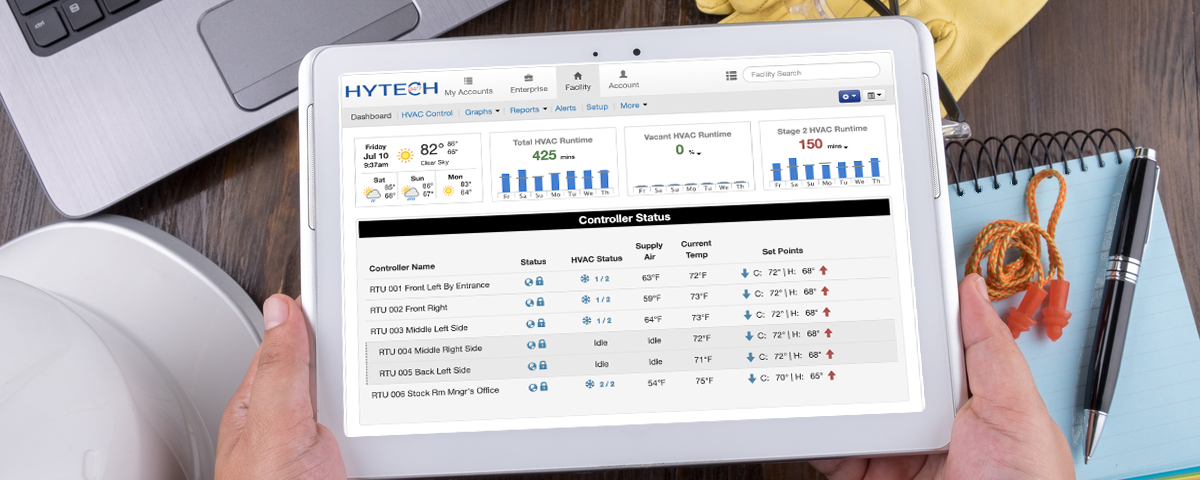Play Offense with Predictive Maintenance, Not Defense with Preventive Maintenance

The traditional “let’s-do-maintenance-for-the-sake-of-maintenance” approach coupled with a quarterly maintenance contract mentality continues to undermine cost management for HVAC service providers. Both facility managers and HVAC service companies know that not every unit requires the same level of maintenance. Different influences affect different units. However, instead of playing defense with arbitrary, way-too-frequent maintenance schedules, company leaders can move to offense and use HVAC data-driven predictive maintenance.
What’s the Difference Between Preventive and Predictive Maintenance?
Preventive maintenance relies on a pre-set list of “needs”. Predictive maintenance uses data to ensure maintenance is performed based on what is actually needed within the system. It’s the same adage as performing maintenance on a car. Older cars followed a preset maintenance schedule. Modern cars use data to consider mileage, performance, and runtime before indicating an oil change or other service is necessary. It’s the same with commercial HVAC maintenance and its reliance on data.
Preventive Maintenance Results in a Higher Total Cost of Ownership in Comparison
The diagnostic skills required for today’s advanced HVAC systems means a high level of training for qualified technicians. Even if a technician took time to learn and memorize all aspects and relationships around HVAC service needs, it is impractical, reports ACHR News:
“Assuming each machine malfunction follows a normal distribution, a technician who sees one new HVAC malfunction every single day could take years to learn the diagnostic skills needed to analyze each function alone. Clearly, it’s impractical and wastes technicians’ valuable time to try to learn and retain everything about the modern HVAC system.”
But an alternative exists. The advancements in technology that allow for dashboard indicators based on data in cars transcend industries and show technicians exactly what needs to happen without endless diagnostics. This augments the skilled technicians with precise support that allows them to be more efficient and effective when performing service and maintenance. This is how they can start playing offense, pivoting to a predictive maintenance program.
Otherwise, maintenance is performed too often, too late to prevent disruption, and too expensive due to excessive hours, higher travel times, and more resources. Preventive maintenance is too much waste. Period. Not only is this approach costly for the building owner, it adds to the costs for the HVAC service provider. Analog HVAC maintenance approaches are cost-prohibitive and put the contractor on defense, not offense.
Predictive Maintenance Is Much More Than Schedules Through the Application of Data
Predictive maintenance gives visibility, control, and energy management to the hands of the people that make the most of it: the HVAC contractor. The digital transformation of maintenance gives the customer the ability to control their unit and comfort all while understanding their energy use. The contractor gains visibility into the unit to track changes, analyze trends, identify issues, and make suggestions to the customer based on data, not hearsay. Through wicked smart analytics, HVAC contractors can transform an ordinary check-up into a data-driven conversation with insights that no other company is offering. See exactly what’s best to maintain each unit, how much that maintenance will cost from year to year, and plan capital budgeting decisions for the future. Since it’s all based on trends and data, it helps HVAC service customers understand their costs and realize that predictive maintenance is saving truck rolls and unnecessary work while enhancing the value of HVAC system service.
Regardless, there are still those who believe any data collection is a predictive maintenance program. That is simply untrue. Data for data’s sake is meaningless. How do you know when the data really indicates a problem and whether the cost is $100 or $1000? The application of the data through connected platforms and analytics is the true predictive maintenance program.
Such benefits of a robust, predictive maintenance program are unit scorecards, predictive fault detection, and facility analysis to educate the customer and create transparency. Prove the HVAC contractors’ value by revealing runtimes of units, estimating maintenance for the upcoming year, and illuminate options for facility cost reductions. The perfect example is a Central Tennessee client of HYTECH 24/7 that was better able to manage the strain on their six package units while reducing energy use and saving maintenance truck rolls. You can read more about that customer here.
5 Steps to Implement Predictive Maintenance
Creating and implementing a predictive maintenance program must go beyond a simple retrofit of the facility HVAC units. Data on its own lacks value, but it is possible to capture, analyze, and apply data by following these crucial steps.
- Identify and install proven IoT devices to communicate to an integrated dashboard and app
- Implement data analysis tools to understand, display, and report the data in a useful way
- Internally verify and trust the data analytics so buy–in can be achieved quickly by the service team
- Apply this data to show customers how their units are performing to change their mind on their maintenance contract
- Build a team to monitor and develop algorithms to constantly provide value, prevent unnecessary truck rolls, increase customer trust and retention, and change the industry
Play Offense with Predictive Maintenance-Driven HVAC Services
If the above five steps sound complicated, imagine the ease of converting them into one step by choosing a proven partner in creating, implementing, and maintaining a data-driven HVAC predictive maintenance program. In fact, HYTECH 24/7 is built on this very opportunity to save money and resources while reaping the rewards of a data-driven maintenance strategy. Find out how to get started by visiting HYTECH 24/7 online today.
